To spot asbestos in your home, check areas like ceilings, insulation, flooring, and older roofing materials, especially in homes built before the 1980s. Look for fibrous textures, wavy patterns, or chalky surfaces, but remember visual identification isn't foolproof—professional testing is vital. Asbestos exposure poses significant health risks, including lung diseases and cancer. Consequently, removal is important; it's the only way to guarantee your safety. Always hire certified professionals for the process, as they follow strict safety protocols and legal regulations. Keep reading to uncover effective ways to manage and prevent asbestos exposure in your environment.
Common Asbestos Locations
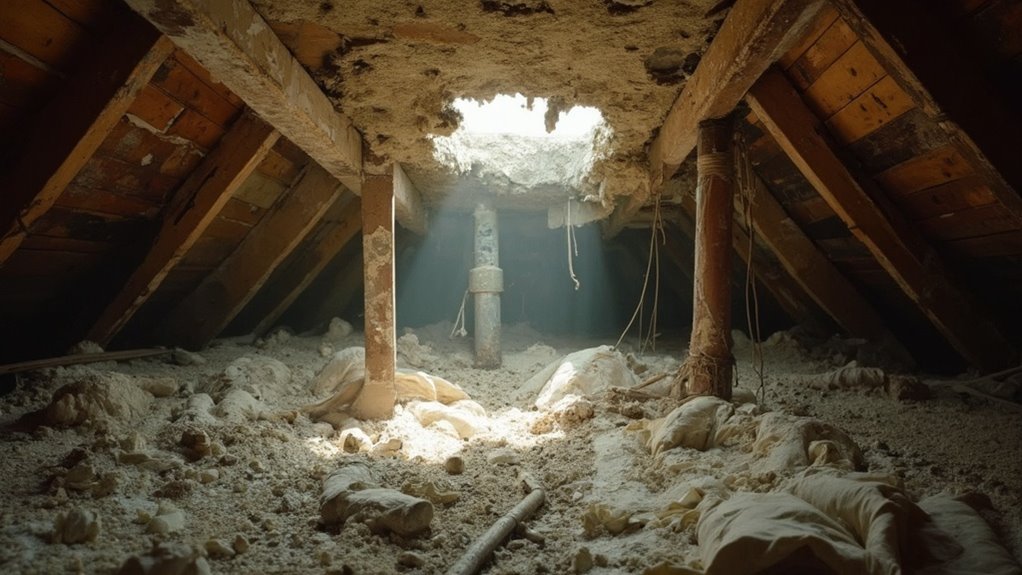
When it comes to identifying potential asbestos hazards in your home, knowing where to look is critical. Asbestos often lurks in various building components, making it fundamental to employ effective asbestos identification techniques. Start by inspecting ceilings, insulation, flooring, drywall, and roofing shingles—these are common locations for asbestos. Outside your home, check gutters, downpipes, fences, and external wall sheeting, as these materials may likewise contain asbestos fibers.
In terms of insulation, be particularly cautious with blown-in attic insulation, vermiculite, and thermal insulation on basement boilers and pipes. Loose fill insulation in roof cavities and duct/pipe insulation are often overlooked areas that can harbor asbestos. Additionally, homes built before the 1980s are more likely to contain asbestos, so it's crucial to be vigilant in these older properties. Improper handling of asbestos can lead to severe respiratory issues, making it essential to approach any suspected materials with care.
Don't forget the hidden spots like attics, crawl spaces, and basements. You might even find asbestos behind kitchen backsplashes or underneath vinyl floor tiles. It's critical to separate fact from fiction regarding common myths surrounding asbestos; just as a material looks modern or safe doesn't mean it's free of asbestos. Always prioritize safety and consult with professionals when in doubt about potential hazards in these common areas.
Visual Indicators of Asbestos
Identifying asbestos visually requires a keen eye for specific characteristics that distinguish it from other materials. When you inspect your home, look for fibrous appearances; this is a key indicator of asbestos. For example, asbestos siding often displays wavy patterns along the bottom edge and features a chalky texture owing to the cement-asbestos mixture. Furthermore, you may notice pressed wood grain designs in asbestos cement siding, which is dense and sturdy owing to the reinforcement with asbestos fibers.
In roofing, asbestos shingles might resemble traditional materials but can still contain asbestos fibers. Similarly, vinyl floor tiles, textured popcorn ceilings, and corrugated pipe wrappings are common places where asbestos lurks. Remember, while visual identification can provide clues, it isn't foolproof. Factors like the invisibility of fibers and potential for false negatives emphasize the need for professional testing. Professional removal eliminates exposure risks for occupants and ensures a safe environment. Laboratory methods such as Polarized Light Microscopy and Transmission Electron Microscopy are crucial for accurate identification. Always prioritize safety and consult experts if you suspect asbestos in your home, as visual indicators alone may not suffice for definitive determinations.
Health Risks of Asbestos Exposure
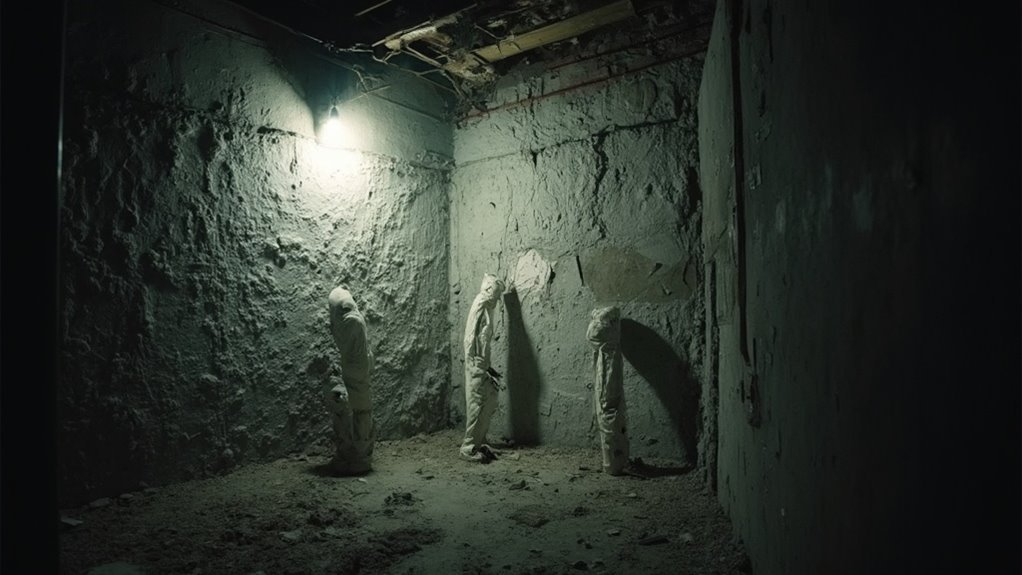
Asbestos exposure poses significant health risks that can manifest many years after initial contact. The exposure timeline for asbestos-related diseases often spans 15 to 50 years, making early detection challenging. You might not recognize asbestos symptoms until significant damage has occurred. Understanding the potential health risks is vital for your safety.
Here are four primary health risks associated with asbestos exposure:
- Lung Diseases: Conditions like asbestosis involve chronic lung scarring and can severely impair respiratory function.
- Cancer Risks: Increased chances of lung cancer and mesothelioma, a rare but aggressive cancer linked exclusively to asbestos.
- Nonmalignant Disorders: You may develop pleural plaques or thickening, which can lead to complications over time.
- Digestive System Concerns: While still under investigation, there are possible links between asbestos and cancers of the esophagus, stomach, and intestine.
No level of asbestos exposure is considered safe, and the risks escalate with cumulative exposure. If you suspect asbestos in your environment, taking immediate action to mitigate that risk is imperative for your health.
Testing Methods for Asbestos
When it comes to testing for asbestos, relying on professional services is vital for accurate results and safety. DIY testing often falls short, as improper sampling can lead to asbestos dispersion and increased risks. Understanding proper sample collection procedures guarantees that you get reliable data, which is fundamental before undertaking any renovation or demolition activities.
Professional Testing Importance
Professional testing for asbestos is crucial for guaranteeing the safety and health of occupants in homes and buildings. Utilizing trained professionals with appropriate qualifications and testing certifications assures reliable results. Here are key aspects of professional testing:
- Air Sampling Techniques: Professionals employ Phase Contrast Microscopy (PCM) and Transmission Electron Microscopy (TEM) to detect asbestos fibers in air.
- Material Testing: Techniques like Polarized Light Microscopy (PLM) analyze bulk samples, identifying asbestos content and type.
- Inspection Protocols: Experts inspect potential asbestos-containing materials, using specialized tools to collect samples without contamination.
- Accredited Laboratories: Samples are sent to accredited labs where advanced methods guarantee accurate analysis and reporting.
These professional methods not only confirm the presence of asbestos but likewise quantify its concentration, providing critical information for subsequent actions. Accurate reporting from accredited laboratories offers recommendations for safe removal or management, adhering to strict quality control standards. By relying on skilled professionals, you minimize risks associated with asbestos exposure and guarantee that your home environment remains safe for all occupants.
DIY Testing Limitations
Many homeowners consider DIY testing kits for asbestos owing to their perceived convenience and cost-effectiveness, but these methods come with significant limitations that can jeopardize safety. First, improper sampling can release dangerous asbestos fibers into the air, creating health risks for you and your family. DIY testing often lacks thorough coverage, failing to assess the entire home, which can lead to asbestos misconceptions about your living environment.
Moreover, DIY kits may yield inaccurate results as a result of their lack of sensitivity and specificity. False negatives can occur, missing low asbestos levels, while false positives can confuse asbestos with non-asbestos fibers. The advanced equipment used in professional laboratories provides far more reliable analyses, detecting even trace amounts of asbestos accurately.
Additionally, DIY testing may not meet regulatory requirements, putting you at risk legally. Without expert guidance following a potential asbestos detection, you might struggle with remediation. In sum, while DIY testing may seem appealing, it can ultimately compromise your safety and understanding of asbestos presence in your home. Prioritizing professional testing is crucial to guarantee accurate detection and effective remediation.
Sample Collection Procedures
Once you've recognized the limitations of DIY testing, the next step is understanding the proper sample collection procedures for asbestos testing. Accurate sampling is critical to guarantee reliable results. Here are four crucial steps you should follow:
- Sample Size: Collect samples measuring one to two square inches, confirming you penetrate any paint or glue for complete material penetration.
- Material Sampling: For various materials, adapt your technique: scrape from drywall joint compounds, collect mastic from tiles, or scoop the bottom half inch of vermiculite insulation.
- Safety Measures: Always wear a NIOSH-approved half-face P100 respirator while sampling to protect yourself from airborne asbestos fibers.
- Storage and Documentation: Immediately seal samples in labeled Ziploc bags and complete a Chain of Custody form to maintain traceability.
These procedures are non-negotiable for effective testing. Proper sample size and thorough material penetration help guarantee that laboratory analysis accurately identifies the presence of asbestos. Remember, handling asbestos is hazardous; if you're uncertain, it's wise to consult a professional. Always prioritize safety and accuracy in your sampling efforts.
Professional vs. DIY Testing
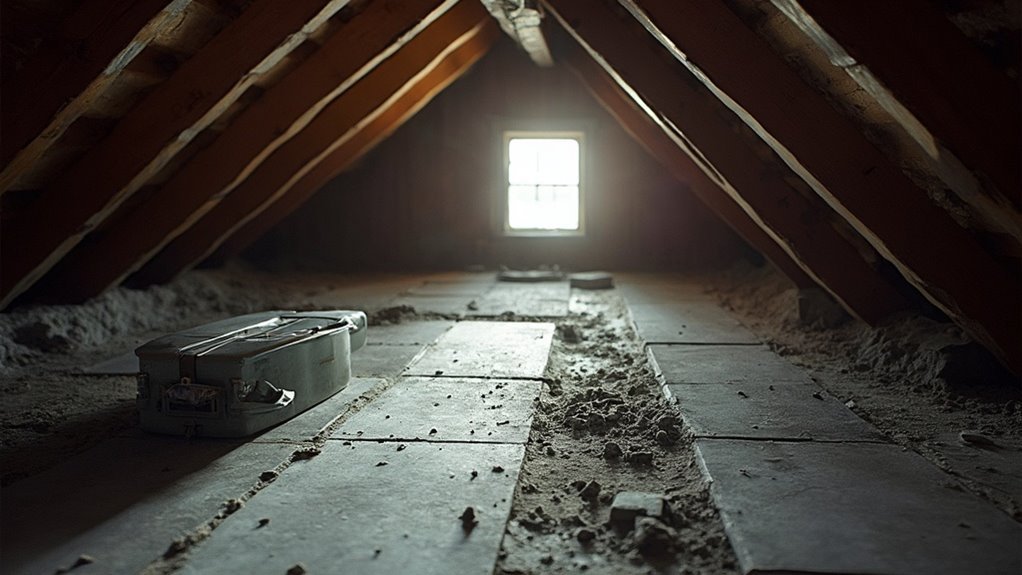
When it comes to testing for asbestos in your home, you face a critical choice between professional services and DIY approaches. Professional testing offers thorough assessments, examining your entire property and identifying all potential asbestos-containing materials (ACMs). This method guarantees high testing accuracy, with trained experts using accredited facilities that adhere to strict safety protocols, considerably reducing risks to you and your family. Nevertheless, professional services can range from $120 to $800, depending on the type of test.
On the other hand, DIY testing kits allow you to collect samples yourself, but they come with notable limitations. Without expertise, you might miss identifying all ACMs, leading to false negatives or unsafe conditions. While DIY kits are typically less expensive, costing as little as $20, they lack the thorough assessment professional services provide. Moreover, you'll need to send samples to a certified lab, potentially incurring extra costs and time.
Asbestos Removal Procedures
When it comes to asbestos removal, you must prioritize safety and adhere to professional requirements. Implementing effective sealing and encapsulation techniques is essential to prevent fiber release during the removal process. Understanding these procedures guarantees a safer environment for everyone involved.
Professional Removal Requirements
Understanding the requirements for professional asbestos removal is fundamental for guaranteeing safety and compliance. When you seek to remove asbestos, it's vital to work with certified professionals who have the necessary removal certifications and contractor qualifications. Here are four key requirements:
- Comprehensive Risk Assessment: A licensed contractor must conduct a thorough assessment to identify hazards and exposure risks.
- Detailed Removal Plan: Based on the risk assessment, a clear plan should outline abatement procedures, containment strategies, and waste disposal methods.
- Legal Compliance: Confirm all legal requirements are met, including obtaining necessary permits and notifications to local authorities.
- Certified Professionals: Always hire licensed asbestos removal contractors who possess appropriate certifications and specialized training.
These steps not only safeguard your health but additionally guarantee compliance with local regulations. Neglecting these requirements can lead to significant risks, including legal repercussions and health hazards. By prioritizing professional removal requirements, you can effectively manage asbestos in your home while protecting yourself and those around you.
#
Safety Measures During Removal
Safety measures during asbestos removal are crucial for protecting both workers and occupants of the home. Utilizing proper safety equipment and effective removal techniques guarantees minimal risk during the process. Here's a concise overview of fundamental precautions:
| Safety Measure | Description |
|---|---|
| Protective Clothing | Wear disposable coveralls and synthetic fabric gear. |
| Respirator Use | Use NIOSH-approved respirators with HEPA filters. |
| Wetting Methods | Apply water to materials to reduce airborne fibers. |
| Containment | Restrict access to work areas to prevent exposure. |
| Decontamination | Clean tools with wet methods and double bag waste. |
When you're conducting the removal, confirm area isolation and minimize cutting whenever possible. If power tools are necessary, use ones equipped with dust collection features. Always clean the workspace thoroughly with HEPA vacuums and wet mops afterward. After removal, conduct air monitoring to verify no asbestos fibers linger. By following these safety measures, you can considerably decrease the risk of exposure during the asbestos removal process.
Sealing and Encapsulation Techniques
Sealing and encapsulation techniques play a vital role in managing asbestos hazards in your home. These methods involve treating asbestos materials with sealants to prevent fiber release, making them suitable for undamaged products. Here are four encapsulation methods you should know:
- Mechanical Encapsulation: Uses board or sheet materials followed by painting.
- High Build Elastomeric Coating: Applies multiple layers of liquid encapsulant for elasticity and impact resistance.
- Penetrating Encapsulants: A spray that penetrates fibrous materials for effective sealing.
- Water-Based Epoxy Resins: Delivers high impact resistance with a cleanable surface, often reinforced with glass fiber.
The encapsulation benefits include minimizing asbestos fiber release, being a faster and more cost-effective solution than removal, and preserving the material's properties. Nevertheless, it's important to recognize that encapsulation isn't a permanent fix and may complicate future removal efforts. Always verify that trained professionals handle the encapsulation process, as they can execute it safely and effectively. Proper application, containment, and air monitoring are fundamental to guarantee the safety of your living environment after encapsulation.
Importance of Professional Removal
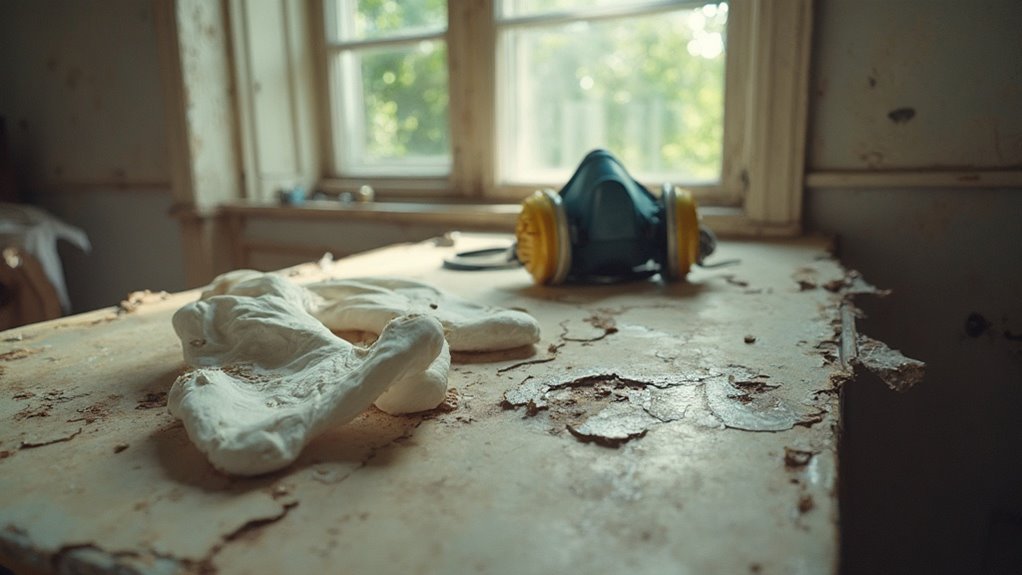
When it comes to asbestos removal, hiring a professional is crucial for guaranteeing the job is done safely and effectively. Professionals undergo thorough expert training and certification, equipping them with the necessary skills to handle asbestos-containing materials (ACMs) properly. They are well-versed in compliance regulations, which means they adhere to local and national standards, reducing the risk of legal issues.
Experts can accurately identify ACMs using specialized tools and techniques that the average person may not possess. Their advanced removal techniques include the use of high-efficiency particulate air vacuums and wet methods to minimize fiber release and guarantee safe containment. Moreover, professionals manage proper disposal in accordance with regulatory standards, safeguarding environmental health.
The benefits of professional removal extend beyond compliance; it considerably lowers health risks associated with asbestos exposure, providing peace of mind. Thorough inspections guarantee that all hidden ACMs are addressed. In addition, post-removal air quality testing guarantees that no harmful fibers remain in your environment. By choosing certified professionals, you protect yourself from potential liabilities and guarantee that the removal process prioritizes safety and efficiency.
## Safety Measures During Removal
When removing asbestos, wearing the right protective gear is vital to safeguard against hazardous fibers. You must likewise implement area containment procedures to prevent the spread of contaminants and guarantee a safe work environment. By following these protocols, you greatly reduce the risk of exposure during the removal process.
Protective Gear Necessities
During asbestos removal, wearing the right protective gear is vital to safeguard your health. Proper safety compliance guarantees you minimize exposure to harmful fibers. Here are the significant protective equipment items you'll need:
- Respirator: A specific respirator designed for asbestos work is mandatory. Choose half-face filter respirators with class P1 or P2 filter cartridges.
- Disposable Coveralls: These prevent contamination of your clothing and should be worn at all times during removal.
- Gloves and Hats: Use disposable gloves and hats to protect your skin and prevent fiber transfer.
- Safety Goggles: Protect your eyes from airborne particles and dust that may arise during the removal process.
Verify your respirator meets Australian Standard AS1716 and fits tightly against your face—clean-shaven is best for an effective seal. Follow manufacturer instructions for fit checks and wear your respirator until all work and cleanup are complete. Remember, proper disposal of contaminated gear is vital; double bag it and label it as "ASBESTOS WASTE." Prioritize your safety by adhering to these protective gear necessities.
Area Containment Procedures
How can you effectively contain an area during asbestos removal to verify safety and compliance? Begin by developing a detailed abatement plan that outlines your containment techniques and worker safety protocols. Isolate the work area to prevent asbestos fibers from spreading. Use poly sheeting to seal off walls, fixtures, and flooring, creating an airtight containment zone.
Implement negative air pressure machines to verify no fibers escape the area. Clearly mark this zone with hazard markings to prevent unauthorized entry, emphasizing its danger. During removal, utilize wet methods and specialized tools to minimize dust generation, further protecting air quality.
Once the asbestos-containing materials are removed, employ HEPA vacuums for thorough cleanup. Conduct air quality testing to confirm that asbestos levels are below safe limits before dismantling the containment area. Remember, the containment zone should only be dismantled once you've verified it's safe, verifying no lingering fibers remain.
Finally, perform a final cleaning and inspection to verify all materials have been properly removed or encapsulated. Following these procedures will help maintain safety and compliance throughout the removal process.
Prevention and Management Strategies
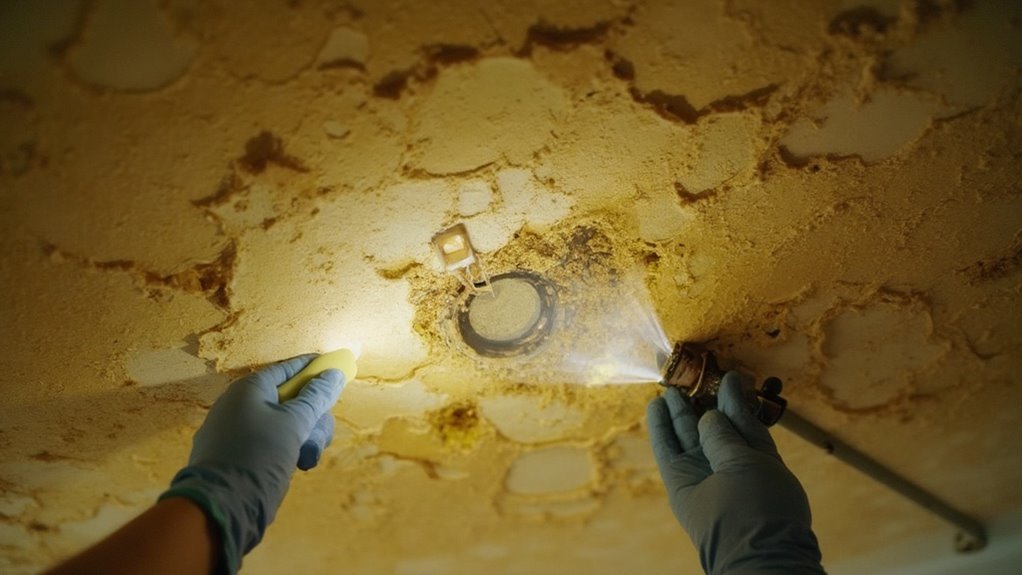
Implementing effective prevention and management strategies is crucial for homeowners to minimize the risks associated with asbestos exposure. By promoting asbestos awareness, you can improve your home safety and protect your family from potential hazards. Here are four key strategies to evaluate:
- Avoid Disturbance: Never disturb materials suspected of containing asbestos. Damaged or crumbling materials can release harmful fibers into your environment.
- Wet Cleaning: Utilize wet cleaning methods and HEPA vacuums to effectively reduce airborne asbestos fibers. This technique minimizes the risk of inhalation during cleaning processes.
- Shoe Management: Wipe your shoes on doormats or remove them before entering your home. This simple action helps prevent tracking asbestos fibers inside.
- Window Control: Keep windows closed on windy days to limit outdoor asbestos fibers from entering your living space.
Regulations and Historical Context
Understanding the regulations and historical context surrounding asbestos is crucial for homeowners concerned about potential exposure. Asbestos regulation history in the U.S. began in the 1930s when early efforts focused on limiting worker exposure and monitoring health impacts. The U.S. Public Health Service's 1938 study incorrectly suggested that low-level exposure posed little risk, a determination that shaped policy for decades. By 1970, the Clean Air Act recognized asbestos as a hazardous pollutant, empowering the EPA to regulate its use and disposal.
The 1970s and 1980s saw significant legislative action, culminating in the 1989 Asbestos Ban and Phase-Out Rule. Even though this rule was largely overturned in 1991, it marked a pivotal moment in acknowledging the public health impact of asbestos. More recent developments, such as the 2019 regulations on discontinued asbestos uses and the 2024 chrysotile asbestos ban, reflect an evolving understanding of asbestos risks. Today, strict regulations govern the handling, import, and use of asbestos, emphasizing the importance of professional abatement. For safety, homeowners should avoid disturbing potential asbestos-containing materials and consult licensed contractors for removal.
Frequently Asked Questions
How Can I Find a Certified Asbestos Professional in My Area?
Finding a certified asbestos professional's like searching for a skilled blacksmith in a medieval village. You'll want to check local health departments, state agencies, and EPA resources for testing and removal techniques.
What Should I Do if I Suspect Asbestos in My Home?
If you suspect asbestos in your home, don't disturb it. Schedule professional asbestos testing immediately to assess health risks. Proper testing guarantees accurate results, minimizing exposure and safeguarding your family's well-being from potential hazards.
Are There Specific Laws Regarding Asbestos Removal in My State?
You need to understand your state's asbestos regulations and guidelines. Each state has specific laws governing removal, requiring permits and licensed professionals. Check local authorities for compliance to guarantee safe and legal asbestos handling.
How Much Does Professional Asbestos Removal Typically Cost?
Professional asbestos removal typically costs between $5 and $20 per square foot, influenced by testing, location, and complexity. The removal process can exceed $5,700 for whole-home remediation, depending on specific areas and materials involved.
What Happens to My Home After Asbestos Removal Is Completed?
After asbestos removal, you'll need thorough post-removal cleanup to confirm safety. Home restoration involves air quality testing, certification, and documentation, assuring a hazard-free environment before you can safely resume normal activities in your home.
